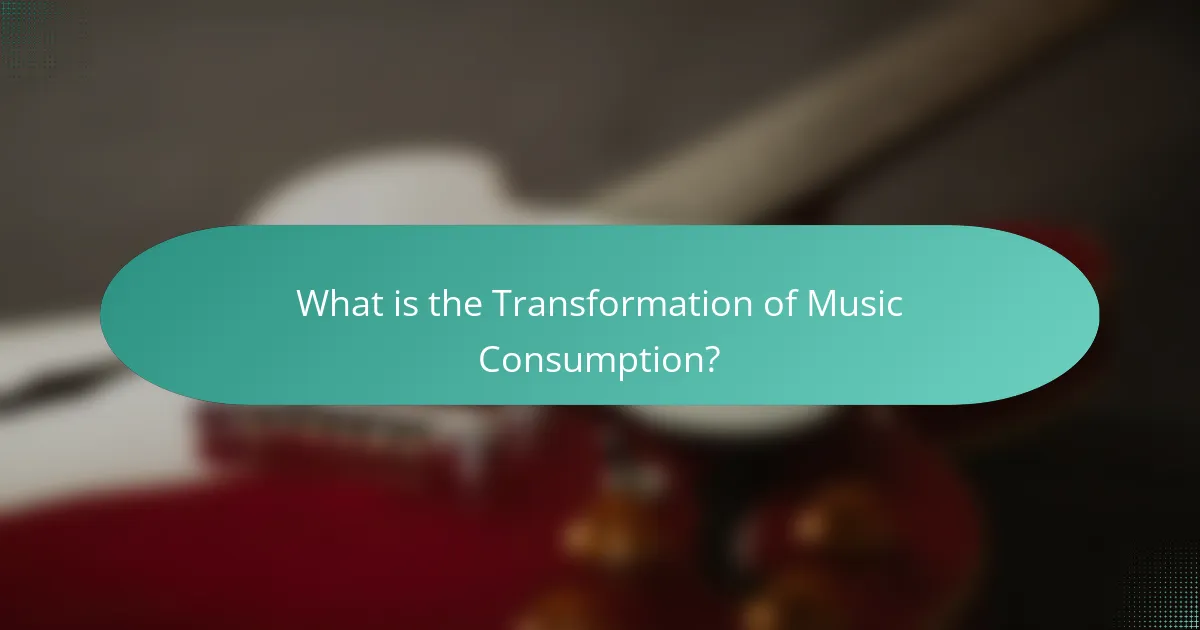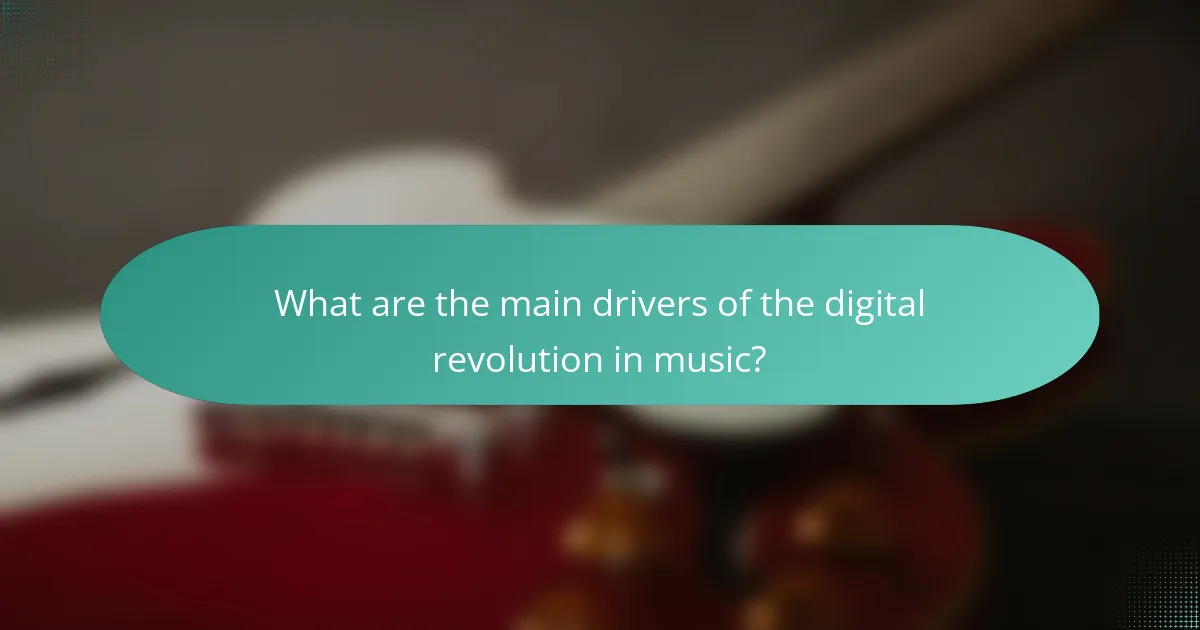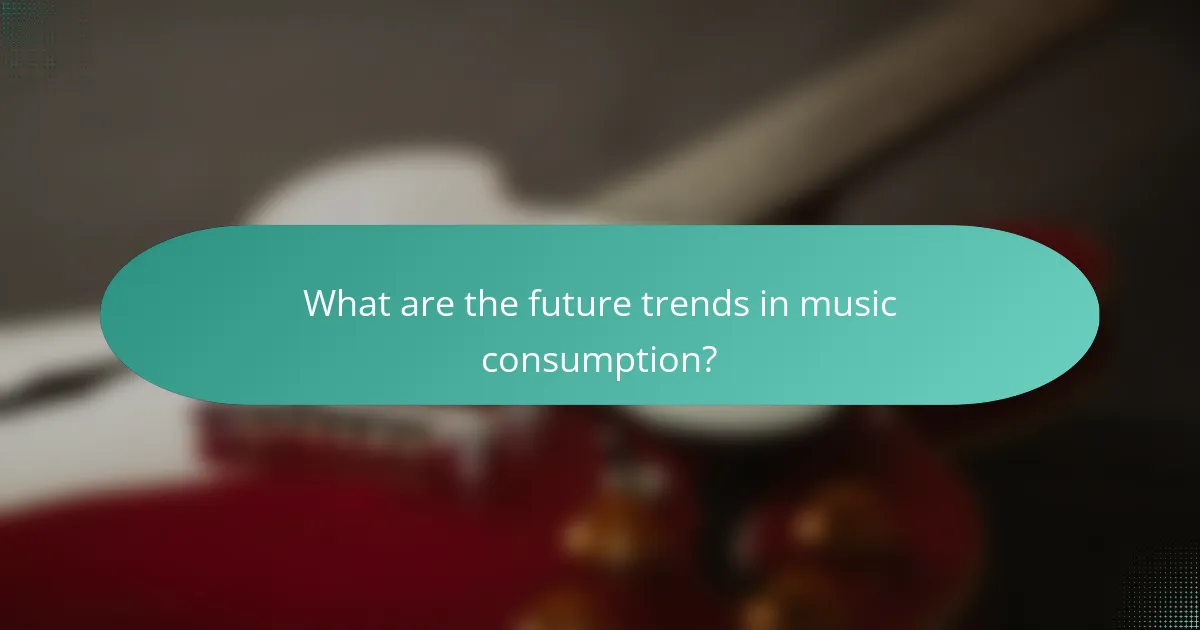The transformation of music consumption highlights the shift from physical formats to digital platforms, significantly influenced by technological advancements and changing consumer preferences. This evolution began in the late 1990s with MP3 technology, leading to the popularity of digital downloads and the emergence of streaming services in the 2000s. Platforms such as Spotify and Apple Music now dominate the market, accounting for over 80% of music industry revenue, and offering vast libraries and personalized recommendations. Future trends indicate a continued rise in streaming, personalized playlists, and the integration of augmented and virtual reality in music experiences, reflecting a demand for convenience and immersive engagement in music consumption.

What is the Transformation of Music Consumption?
The transformation of music consumption refers to the shift from physical formats to digital platforms. This change began in the late 1990s with the rise of MP3 technology. Digital downloads became popular, allowing users to purchase individual songs instead of entire albums. Streaming services emerged in the 2000s, revolutionizing access to music. Platforms like Spotify and Apple Music offer vast libraries for a monthly fee. This shift has altered how artists distribute their music and how consumers engage with it. Statistics show that streaming now accounts for over 80% of music industry revenue. This transformation reflects broader trends in technology and consumer behavior.
How has the digital revolution impacted music consumption?
The digital revolution has significantly transformed music consumption. It has shifted the primary method of accessing music from physical media to digital platforms. Streaming services like Spotify and Apple Music now dominate the market. In 2020, streaming accounted for 83% of music industry revenue in the U.S. This transition allows users instant access to vast libraries of music. Consumers can create personalized playlists and discover new artists easily. The digital format also enables music sharing and social interaction around songs. Additionally, artists can distribute their music independently, bypassing traditional record labels. This democratization has changed how music is produced and marketed.
What are the key changes in music distribution methods?
Music distribution methods have shifted significantly due to digital technology. Traditional methods relied on physical formats like CDs and vinyl records. The rise of the internet introduced digital downloads, allowing consumers to purchase and own music files. Streaming services like Spotify and Apple Music have transformed access, enabling users to listen without ownership. Social media platforms now serve as promotional tools for artists, reaching wider audiences. Direct-to-fan sales through platforms like Bandcamp empower musicians to connect with listeners directly. These changes reflect a move towards convenience and accessibility in music consumption. The global music industry revenue from streaming surpassed $20 billion in 2020, highlighting this shift’s impact.
How have consumer preferences shifted with digital music?
Consumer preferences have shifted significantly with digital music. Many listeners now prefer streaming services over purchasing physical albums. According to the Recording Industry Association of America (RIAA), streaming accounted for 83% of the U.S. music industry’s revenue in 2020. This shift indicates a move towards convenience and accessibility. Consumers favor curated playlists and personalized recommendations. The rise of platforms like Spotify and Apple Music has changed how music is discovered. Additionally, the ability to access vast libraries of music on-demand has influenced listening habits. Social media platforms also play a role in shaping music preferences. Overall, digital music has transformed how consumers engage with and consume music.
Why is understanding consumer behavior important in music consumption?
Understanding consumer behavior is crucial in music consumption because it informs how artists and companies tailor their offerings. By analyzing preferences, trends, and purchasing habits, stakeholders can create targeted marketing strategies. For instance, data shows that 70% of consumers prefer streaming services over physical media. This shift highlights the need for businesses to adapt to digital platforms. Additionally, understanding demographics helps in predicting future trends. Research indicates that millennials and Gen Z are the primary drivers of music consumption changes. Therefore, insights into consumer behavior can enhance engagement and profitability in the music industry.
What factors influence consumer choices in music formats?
Consumer choices in music formats are influenced by several key factors. These factors include convenience, sound quality, price, and access to technology. Convenience plays a significant role, as digital formats allow for easy portability and instant access. Sound quality is critical for audiophiles who prefer high-resolution formats. Price sensitivity affects choices, with many consumers opting for free or low-cost streaming services. Access to technology also shapes preferences, as consumers with smartphones and high-speed internet are more likely to choose digital formats. Research by the International Federation of the Phonographic Industry (IFPI) indicates that 56% of consumers prefer streaming services due to their accessibility and variety.
How do demographics affect music consumption patterns?
Demographics significantly influence music consumption patterns. Age groups show varied preferences, with younger audiences favoring streaming services. Older generations often prefer radio or physical media. Gender also plays a role; studies indicate women are more likely to use platforms like Spotify. Income levels impact access to premium services, affecting overall consumption. For example, higher-income individuals tend to subscribe to multiple music services. Additionally, cultural background shapes genre preferences, leading to diverse listening habits. According to a Nielsen report, millennials listen to music more than any other age group, highlighting demographic shifts in consumption.

What are the main drivers of the digital revolution in music?
The main drivers of the digital revolution in music are technological advancements, changing consumer behavior, and the rise of streaming services. Technological advancements have made music production and distribution more accessible. Digital audio workstations allow artists to create high-quality music from home. The internet enables instant sharing and global reach for music. Changing consumer behavior reflects a preference for on-demand access over ownership. Consumers now favor streaming platforms that offer vast libraries of music. The rise of streaming services like Spotify and Apple Music has transformed how people listen to music. These platforms provide personalized recommendations and curated playlists, enhancing user experience. According to a report by the Recording Industry Association of America, streaming accounted for 83% of the U.S. music industry revenue in 2020. This shift highlights the dominance of digital consumption in the music landscape.
How has technology influenced music accessibility?
Technology has significantly enhanced music accessibility. The advent of the internet has allowed consumers to access vast libraries of music instantly. Streaming services like Spotify and Apple Music provide millions of songs at users’ fingertips. These platforms often offer free or low-cost subscriptions, making music affordable for a wider audience. Mobile devices enable listening on-the-go, further increasing accessibility. Social media platforms allow artists to share their music directly with fans. This direct connection eliminates traditional barriers like record labels. According to the Recording Industry Association of America, streaming now accounts for over 80% of music revenue. This shift illustrates how technology has transformed music consumption and accessibility.
What role do streaming services play in music consumption?
Streaming services are central to modern music consumption. They provide on-demand access to vast libraries of songs. Users can listen to music anytime and anywhere with an internet connection. This convenience has shifted listening habits from physical media to digital formats. According to the Recording Industry Association of America, streaming accounted for 83% of music industry revenue in 2021. This statistic illustrates the dominance of streaming over traditional sales. Additionally, streaming services offer personalized playlists and recommendations, enhancing user engagement. As a result, they have transformed how audiences discover and consume music.
How have social media platforms changed music discovery?
Social media platforms have revolutionized music discovery by enabling artists to reach wider audiences instantly. Platforms like Instagram, TikTok, and Twitter allow musicians to share their work directly with fans. This direct interaction fosters a sense of community and engagement. Algorithms on these platforms curate personalized content, making it easier for users to discover new music. In 2021, TikTok was responsible for 175 songs reaching the Billboard Hot 100. Additionally, user-generated content and viral challenges promote songs organically. This democratizes music promotion, allowing independent artists to gain visibility without major label support. Overall, social media has transformed how listeners find and connect with music.
What impact does mobile technology have on music consumption?
Mobile technology significantly alters music consumption patterns. It enables instant access to vast libraries of music through streaming services. Consumers now prefer listening on-the-go, facilitated by smartphones and apps. This shift has led to a decline in physical sales and downloads. According to the Recording Industry Association of America, streaming accounted for 83% of music industry revenue in 2020. Mobile technology fosters personalized playlists and recommendations, enhancing user experience. Social media integration allows sharing and discovery of music easily. Overall, mobile technology reshapes how music is accessed, shared, and enjoyed.
How do mobile apps enhance the listening experience?
Mobile apps enhance the listening experience by providing personalized content and seamless access to music. They utilize algorithms to recommend songs based on user preferences. This personalization increases user engagement and satisfaction. Additionally, mobile apps offer features like offline listening, allowing users to enjoy music without internet connectivity. Some apps include curated playlists, which help users discover new artists and genres. The integration of social sharing features enables users to connect with friends and share their favorite tracks. According to a study by Deloitte, 80% of music listeners prefer apps for their convenience and customization. These factors collectively contribute to a richer and more enjoyable listening experience.
What are the implications of mobile music consumption trends?
Mobile music consumption trends indicate a shift towards streaming services and personalized playlists. This transition has led to increased accessibility for users. Consumers now prefer on-demand access to music over ownership. As a result, physical sales have declined significantly. According to the Recording Industry Association of America, streaming accounted for 83% of the U.S. music industry revenue in 2020. Mobile devices have become the primary medium for music listening. This trend has influenced how artists promote their work. Social media platforms play a crucial role in music discovery. Overall, these trends reshape the music industry landscape and consumer engagement.

What are the future trends in music consumption?
Future trends in music consumption include increased streaming, personalized playlists, and enhanced virtual experiences. Streaming services dominate the market, with over 80% of music revenue coming from them in 2022. Users prefer curated playlists tailored to their tastes, leading to a rise in algorithm-driven recommendations. The integration of augmented reality (AR) and virtual reality (VR) is set to transform live music experiences. Additionally, social media platforms are becoming key venues for music discovery and promotion. As technology evolves, the demand for high-quality audio formats is also expected to grow. These trends reflect a shift towards convenience, personalization, and immersive experiences in music consumption.
How will emerging technologies shape music consumption?
Emerging technologies will significantly shape music consumption by enhancing accessibility and personalization. Streaming platforms utilize algorithms to recommend music tailored to individual preferences. This leads to increased user engagement and satisfaction. Virtual reality and augmented reality create immersive listening experiences, allowing users to feel more connected to artists. Blockchain technology may revolutionize copyright management and revenue distribution for artists. Additionally, advancements in artificial intelligence enable music creation and curation at unprecedented levels. These technologies collectively foster a more interactive and user-driven music landscape.
What potential does artificial intelligence hold for music curation?
Artificial intelligence has significant potential for music curation. It can analyze vast amounts of data to identify patterns in listener preferences. AI algorithms can recommend music tailored to individual tastes. This personalization enhances user experience and engagement. Machine learning models can also predict emerging trends in music. For instance, Spotify’s AI-driven playlists adapt based on user interactions. Additionally, AI can assist in discovering new artists by analyzing social media and streaming data. This capability supports independent musicians by increasing their visibility. Overall, AI transforms music curation into a more dynamic and personalized process.
How might virtual reality change music experiences?
Virtual reality may revolutionize music experiences by creating immersive environments for listeners. Users can attend virtual concerts from anywhere in the world. This technology allows for interactive performances, where audiences can engage with artists in real time. Virtual reality can also enhance music education by simulating real-life instruments and environments. Studies show that immersive experiences can increase emotional engagement with music. For example, a 2021 study by the University of California found that participants felt more connected to music in virtual settings. Overall, virtual reality offers new ways to experience and interact with music, broadening accessibility and engagement.
What strategies can artists use to adapt to changing consumer behavior?
Artists can adapt to changing consumer behavior by leveraging digital platforms. They can utilize social media to engage directly with fans. This builds a loyal community and increases visibility. Artists should also explore streaming services to distribute their music. Streaming has become the primary method of music consumption. Collaborating with influencers can amplify reach and attract new listeners. Additionally, artists can offer exclusive content through platforms like Patreon. This creates a direct revenue stream and fosters fan loyalty. Finally, analyzing consumer data helps artists understand trends and preferences. This data-driven approach allows for tailored marketing strategies.
How can musicians leverage data analytics for audience engagement?
Musicians can leverage data analytics to enhance audience engagement by analyzing listener preferences and behaviors. They can track streaming data to understand which songs resonate most with fans. This analysis helps in tailoring marketing strategies for specific demographics. By utilizing social media analytics, musicians can gauge fan interaction and content effectiveness. Data on concert attendance can inform decisions on tour locations and setlists. Additionally, email marketing metrics can guide personalized communication with fans. According to a report by Nielsen Music, 79% of music listeners engage with artists through social media, highlighting the importance of data-driven strategies.
What are best practices for promoting music in a digital age?
Utilizing social media platforms is essential for promoting music in a digital age. Artists should engage with fans directly on platforms like Instagram, Twitter, and TikTok. Regularly posting content keeps the audience interested and informed. Collaborating with influencers can expand reach and attract new listeners. Streaming services like Spotify and Apple Music should be leveraged for playlist placements. Data shows that songs featured on popular playlists can increase streams significantly. Email marketing remains effective for direct communication with fans. Building a mailing list allows artists to share updates and exclusive content. Additionally, creating visually appealing music videos can enhance engagement on platforms like YouTube. Research indicates that videos can increase listener retention and interest. Finally, hosting virtual concerts can create unique experiences for fans and broaden audience reach. These practices collectively enhance visibility and engagement in a competitive digital landscape.
The main entity of the article is the transformation of music consumption, focusing on the shift from physical formats to digital platforms. The article examines the impact of the digital revolution on music access, distribution methods, and consumer preferences, highlighting the dominance of streaming services in the industry. It explores how technology and social media have reshaped music discovery and engagement, while also discussing the implications of changing demographics and consumer behavior. Additionally, the article outlines future trends in music consumption and strategies for artists to adapt to these changes effectively.